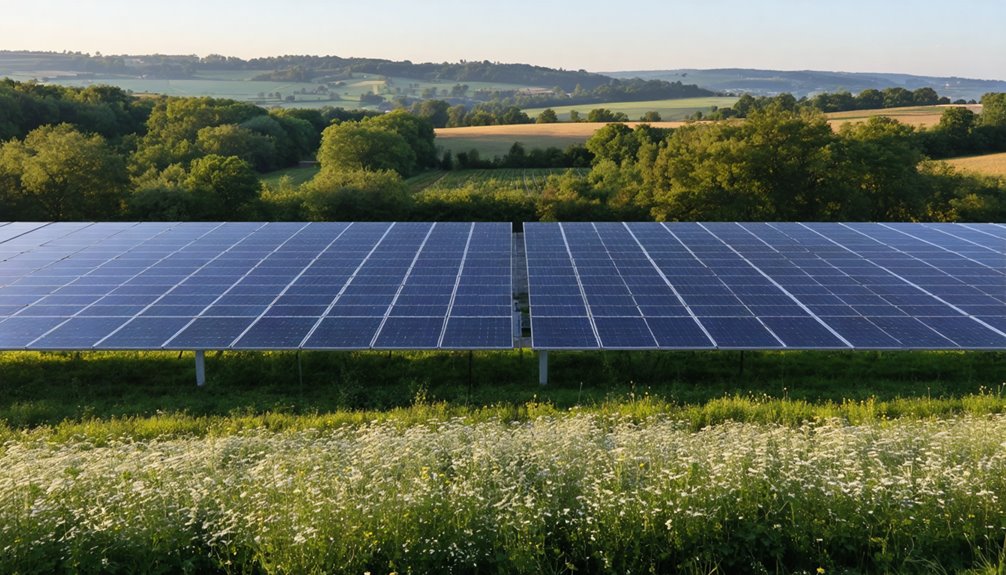Ground-mounted solar panels often need planning permission due to their potential to affect local aesthetics and environments. Installations exceeding 9m² or 4m in height typically require consent, especially if located within 5 meters of property boundaries or in conservation areas. For listed buildings, stricter conditions apply, necessitating both planning and listed building consents. While some projects may qualify as permitted developments, consulting local authorities early helps you understand specific requirements and enhance project success. Explore further for extensive insights.
Understanding the Basics of Ground-Mounted Solar Panels
When considering the installation of ground-mounted solar panels, it’s important to understand their fundamental characteristics and benefits, particularly in comparison to their rooftop counterparts. Ground-mounted solar panels are versatile and installed directly into the ground, utilizing photovoltaic systems similar to rooftop versions. A thorough assessment of wind loading and other environmental factors is essential to ensure long-term structural stability. However, they offer superior energy efficiency due to ideal tilt and orientation towards the sun. The installation process often involves securing the panels with concrete ballasts, driven piers, or helical piles, chosen according to site conditions. Planning permission is typically required from local authorities if installations surpass 9m² or 4m in height, especially in residential areas. Additionally, incorporating tracking systems into the design enables panels to follow the sun’s path, potentially increasing electricity output by up to 40%.
Permitted Development Rights for Ground-Mounted Installations
Permitted development rights for ground-mounted solar installations can markedly influence the planning process by easing certain regulatory hurdles, yet these rights are subject to specific conditions and restrictions that must be carefully observed. Ground-mounted solar systems generally require planning permission if they exceed 9m² or 4m in height and if they’re placed within 5 meters of property boundaries. However, under specific size and height conditions, they can be classified as permitted development, simplifying the process. In conservation areas, stricter rules may necessitate a planning application despite compliance with standard rights. A Certificate of Lawful Development can offer clarity regarding whether your installation project falls within permitted rights, yet it is essential to recognize that this certificate does not offer legally binding confirmation on planning permission status. Additionally, in some regions the cost and ease of navigating permissions can vary with project scale and location, and the siting constraints of a site—such as available land—can be decisive for choosing ground-mounted versus rooftop installations land availability.
Assessing Location and Visibility Concerns
Although the prospect of installing ground-mounted solar panels can be enticing due to the potential for increased energy efficiency and sustainability, one must carefully assess location and visibility to comply with planning regulations and optimize system performance. A crucial factor is understanding planning permission requirements early to avoid delays. Ground-mounted solar installations exceeding 9m² in area or 4m in height typically require planning permission. Positioning must keep a minimum distance of 5 meters from property boundaries to mitigate visibility concerns. Local planning authorities assess how installations impact the surrounding environment and local aesthetics, emphasizing compliance with regulations. Environmental impact plays an important role during evaluations, often necessitating consultations with authorities to address potential visibility challenges. Proper assessment guarantees that installations integrate seamlessly with their surroundings while adhering to necessary planning permissions.
Regulations for Conservation Areas and Listed Buildings
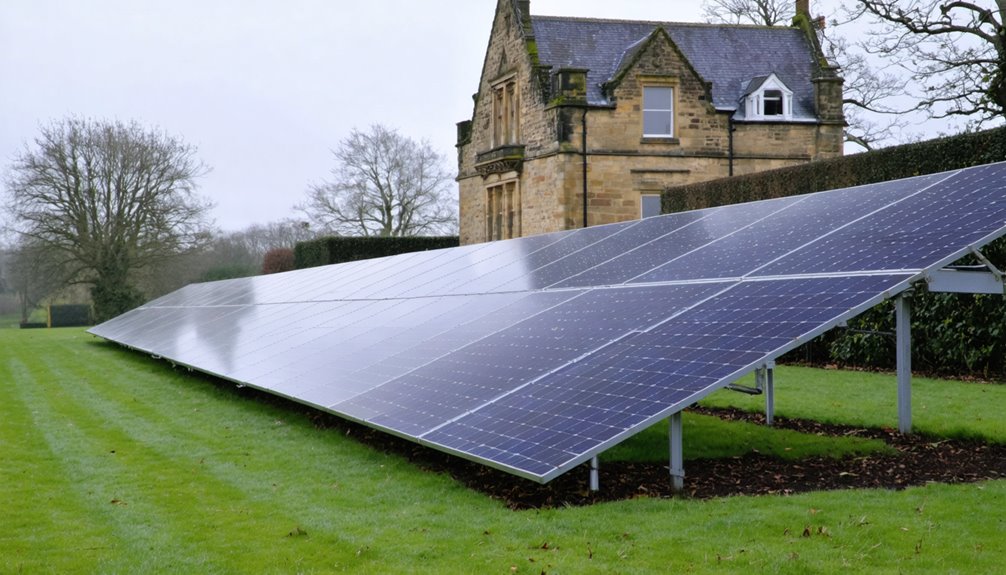
Ground-mounted solar panels in conservation areas and on listed buildings are subject to stringent regulations to preserve both historical integrity and local aesthetics, reflecting the need for balance between technological advancement and cultural heritage. In conservation areas, ground-mounted solar installations may not require planning permission if they’re not visible from public highways; however, visibility requirements vary by local planning authorities. On listed buildings, obtaining both planning permission and listed building consent is vital due to their historical significance. Authorities thoroughly assess the visual impact of these solar panels, ensuring minimal disruption to the area’s aesthetic characteristics. You can apply for a Certificate of Lawful Development if you’re in a conservation area, but this doesn’t guarantee your installation’s acceptance. Compliance with height and size limits remains essential.
Evaluating Size and Structure Restrictions
When considering the installation of ground-mounted solar panels, understanding size and structure restrictions is vital for compliance with planning regulations. These panels must not exceed 4 meters in height or cover more than 9 square meters to avoid the necessity of planning permission. Additionally, they need to be placed at least 5 meters from property boundaries. With taller installations potentially posing visual and environmental impacts, stricter scrutiny is anticipated during planning. Particularly in conservation areas, restrictions may include limitations on visibility from the road, requiring careful planning application considerations. Adhering strictly to these specified size and structure restrictions is imperative to prevent delays and guarantee your project’s planning permission is granted smoothly. Failure to comply can complicate the entire installation process considerably. Additionally, check whether your project qualifies for planning permission exemptions in your area, since rules can vary by location.
Policy Differences in Residential and Commercial Projects
When exploring the policy differences between residential and commercial ground-mounted solar panel projects, you’ll find that regulatory compliance varies greatly, with residential installations often being subject to simpler regulations. Commercial projects need to navigate a more involved application process, frequently requiring local planning authority approval due to their potential impact on local infrastructure and environment. Additionally, both project types must adhere to specific impact assessment criteria, especially in conservation areas and for listed buildings, to guarantee alignment with local and national planning policies while considering the aesthetic and heritage implications.
Regulatory Compliance Variances
Although both residential and commercial ground-mounted solar panel installations generally require planning permission, the specifics of regulatory compliance can vary considerably depending on the project’s nature and location. For residential installations, regulatory compliance often involves ensuring the system is at least 5m from property boundaries and adheres to size limitations. Commercial solar projects, however, face more stringent regulations that often necessitate approval from local planning authorities regardless of the system’s size. The National Planning Policy Framework advocates for renewable energy development, encouraging local authorities to grant planning permission for ground-mounted solar if impacts are acceptable. Regional variations can arise, as interpretations of regulations by local planning authorities may differ, influencing the compliance process based on the National Planning Policy Framework’s guidance.
Application Process Differences
Understanding the application process for ground-mounted solar panel installations involves recognizing the distinct policy differences that exist between residential and commercial projects. Residential ground-mounted solar systems, often under permitted development, may not need planning permission if they are under specific size and height limits and are distanced appropriately from property boundaries. However, commercial installations typically require more robust planning permission due to their larger scale and stricter regulatory environment. Early consultation with local planning authorities is essential in both cases to identify any potential site-specific requirements or environmental considerations. Incorporating National Planning Policy Framework (NPPF) guidelines, these processes guarantee alignment with renewable energy goals and local regulations.
| Project Type | Permission Requirement | Additional Considerations |
|---|---|---|
| Residential | May not require if within specified limits | Check with local planning authority |
| Commercial | Generally requires permission | Adhere to stricter regulations |
| Regular Consultation | Important for both types | Environmental and compliance checks |
Impact Assessment Criteria
In evaluating the impact of ground-mounted solar panels, local planning authorities meticulously examine the differences between residential and commercial projects, each with distinct criteria grounded in regulatory frameworks and environmental considerations. For residential installations, planning permission is generally required if panels exceed 9m² or stand taller than 4m, with a mandatory 5m distance from boundaries. Commercial projects face stringent regulations, necessitating planning permission due to their larger size. Local Planning Authorities assess various environmental impacts, such as glare, wildlife disruption, and visual landscape changes. Aligning with the National Planning Policy Framework, these authorities encourage renewable energy projects, provided they don’t negatively impact local infrastructure and community. Early consultation with LPAs and community engagement are essential in maneuvering specific local policy differences.
Early Consultation With Local Planning Authorities
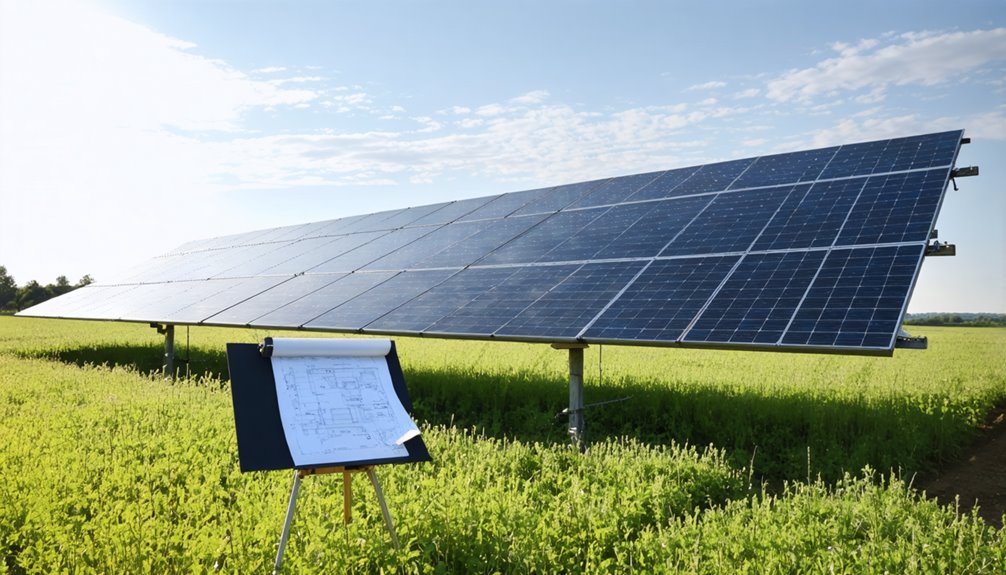
Engaging in early consultation with local planning authorities (LPA) is a critical step to guarantee the successful installation of ground-mounted solar panels, as it allows you to clarify specific requirements and potential restrictions that may be pertinent to your area. Early consultation helps identify any local policies affecting the planning permission process for ground-mounted systems, detailing potential environmental impact concerns that could arise. By proactively discussing these aspects with the LPA, you can streamline the planning application, increasing your chances of approval. Furthermore, these discussions provide an opportunity to receive feedback on the design and positioning of your solar panels, ensuring compliance with regulations and enhancing neighborhood compatibility. Engaging in this process effectively addresses potential issues before formally submitting your application.
Environmental Impact and Community Considerations
While planning ground-mounted solar panel projects, it’s essential to assess the environmental impact and consider community factors, as these elements greatly influence planning permission outcomes. In some cases, ground-mounted layouts can incorporate tracking systems to boost energy yields while maintaining biodiversity considerations. Ground-mounted installations must address potential issues like glare, wildlife disruption, and visual changes, especially in protected areas. Planning permission is more stringent in regions such as conservation zones and Areas of Outstanding Natural Beauty, as these prioritize environmental aesthetics and habitat preservation. The National Planning Policy Framework encourages renewable energy that respects community values and minimizes environmental harm. Community engagement and early consultations with local authorities can facilitate smoother approvals by addressing concerns. Thoughtful placement and design of solar installations can enhance biodiversity, potentially reducing habitat disruption and enriching local green spaces.
Significance of Property Boundaries and Setback Requirements
Property boundaries and setback requirements play a critical role in the planning and placement of ground-mounted solar panels, affecting how close these structures can be to neighboring properties. These regulations help minimize the visual impact on neighbors and maintain privacy. Panels must be at least 5 meters from property boundaries. If they exceed 9m² or 4 meters in height, planning permission is usually necessary. Requirements vary with local planning authorities, so consult them to avoid complications.
| Requirement | Condition | Impact |
|---|---|---|
| Distance | 5 meters | Maintain privacy and minimize visual impact |
| Size for Permission | Exceeds 9m² | Planning permission likely needed |
| Height for Permission | Exceeds 4m | Potential planning requirement |
| Local Interpretation | Varies | Necessitates consultation |
| Compliance Failure | Risk enforcement | Possible removal of installation |
Failing to adhere may lead to enforcement action.
Special Considerations for Agricultural Land
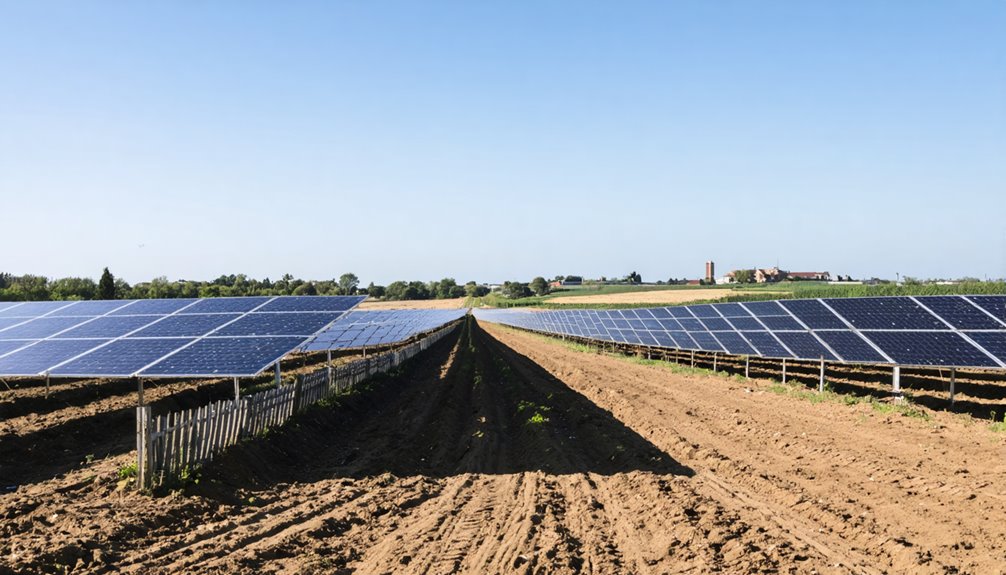
When installing ground-mounted solar panels on agricultural land, it’s vital to understand the regulatory landscape, as planning permission is generally a requirement due to the protective measures in place for agricultural use. The installation must consider the land’s primary function; if it greatly affects agricultural productivity, permissions are less likely to be granted. Local planning authorities provide specific guidelines regarding installation regulations, including the permissible size of ground-mounted solar systems. Typically, if these systems exceed 9m² or reach heights over 4m, planning permission is necessary. To guarantee compliance, consulting with the local planning office early is important as it helps you navigate the complexities of agricultural land regulations related to solar installations and facilitates informed decisions within permissible frameworks.
Detailed Steps for Applying for Planning Permission
How do you effectively navigate the process of applying for planning permission for ground-mounted solar panels? Initially, consult with your local planning authority to determine if your project requires planning permission, especially when installations exceed 9m² or 4m in height. Complete your application through the Planning Portal, submitting essential documents like site plans and visual impact assessments to prevent delays. During the approximate eight-week processing period, be ready to provide additional information if requested. Engaging early with your local planning authority and community can preempt concerns regarding the installation’s impact. Adhering strictly to building regulations and local guidelines is imperative, as non-compliance can result in application rejection, underscoring the importance of meticulous attention to detail during the application process.
Best Practices for Maximizing Solar Panel Efficiency
To maximize solar panel efficiency, you should guarantee ideal panel orientation by positioning ground-mounted systems facing south in the UK, thereby maximizing sunlight exposure and energy production. In addition, it’s vital to conduct regular maintenance checks, which include cleaning panels and removing debris, to maintain unrestricted energy capture and operational efficiency. Avoid installing panels in shaded areas as strategic shading avoidance is essential for optimal performance, guaranteeing panels capture the maximum amount of sunlight throughout the day.
Optimal Panel Orientation
Why is panel orientation important in maximizing the efficiency of ground-mounted solar panels? The ideal tilt angle, ranging from 30 to 40 degrees, plays a critical role in increasing sunlight exposure for ground-mounted solar panels. Facing them south in the UK guarantees they capture sunlight effectively throughout the day. Implementing solar tracking systems can further enhance efficiency by adjusting the orientation to follow the sun’s movement, potentially boosting energy output by up to 40%. To achieve peak performance, it is necessary to avoid shading from nearby structures or trees, as this can drastically reduce efficiency. Proper spacing between panels, ideally 10 to 15 feet, prevents shading between rows and allows for easy maintenance, ensuring the system operates at its best capacity.
Regular Maintenance Checks
Ensuring the ideal performance of ground-mounted solar panels necessitates regular maintenance checks, as these checks play a essential role in sustaining energy efficiency. It’s critical to inspect for dirt and debris at least twice a year; this promotes best panel performance by minimizing efficiency loss. By adjusting tilt and orientation, you can boost energy production by 20-40%, ensuring maximum sun exposure. Monitoring the inverter’s performance helps identify faults early, important in avoiding decreased system efficiency. Regular structural assessments prevent damage, securing both longevity and safety. Vegetation management is key to reducing shading and maintaining energy output. Incorporate these practices into a systematic routine to enhance panel performance.
| Task | Frequency | Outcome |
|---|---|---|
| Clean Panels | Twice yearly | Enhanced panel performance |
| Check Inverter’s Performance | Regularly | Consistent energy production |
| Structural Report | Annually | System longevity and safety |
Strategic Shading Avoidance
Regular maintenance checks establish a foundation for ideal solar panel performance, and now safeguarding against shading becomes essential in maintaining this efficiency. Shadows from nearby structures or vegetation can severely impact the effectiveness of ground-mounted solar panels by obstructing sunlight, so you’re advised to assess and remove these obstructions regularly. Ideally, position your panels where they receive at least six hours of direct sunlight daily. Orientation is vital, with a southern-facing direction in the UK being best for maximizing solar capture. You can consider implementing solar tracking systems to enhance productivity further, adjusting your panels to align with the sun’s path and boosting energy production by up to 40%. While planning permission might focus on aesthetics, operational efficiency underscores strategic site management.
Comparing Ground-Mounted and Rooftop Solar Options
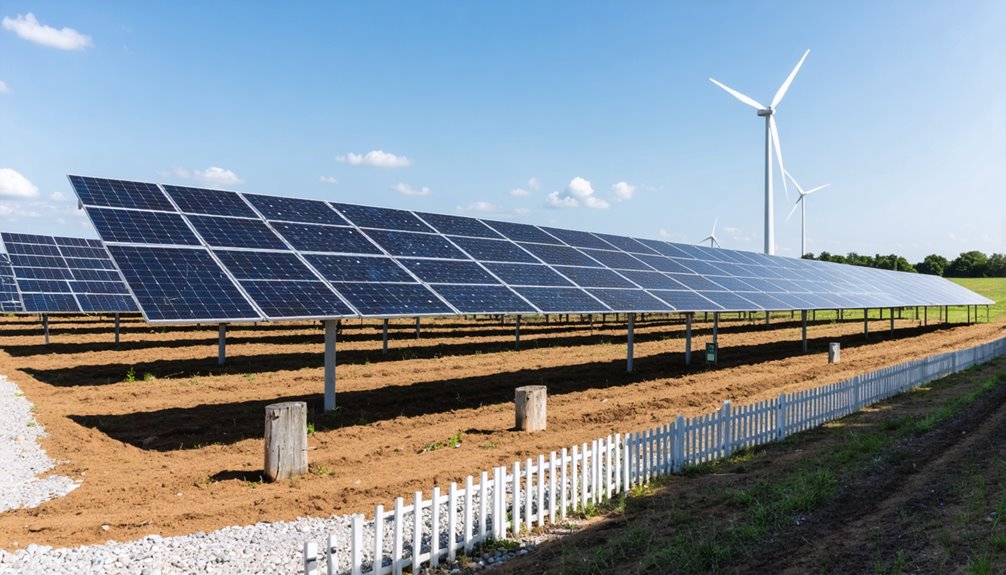
While considering the installation of solar panels, it’s important to weigh the differences between ground-mounted and rooftop solar options, as each presents its own set of benefits and challenges depending on your specific circumstances. Ground-mounted systems may require planning permission if they exceed certain dimensions, unlike rooftop solar installations, often considered permitted developments. However, ground-mounted panels can achieve optimum energy efficiency, accommodating tilted and tracking mechanisms, unlike rooftop systems. In contrast, rooftop installations utilize existing structures, reducing costs but potentially limiting array size.
| Feature | Ground-Mounted | Rooftop Solar |
|---|---|---|
| Planning Permission | Often required for larger setups | Usually not needed |
| Installation Costs | Higher due to foundational needs | Lower utilizing existing rooftops |
| Energy Efficiency | Higher with adjustable orientation | Fixed, potentially less efficient |
Ground installations offer scalability and easy maintenance, albeit with complex permitting.
Potential Challenges and Solutions in the Permitting Process
When maneuvering through local regulations for ground-mounted solar panels, you’re likely to encounter strict guidelines, especially in conservation areas that require careful environmental impact assessments to address potential disruptions to local wildlife. Engaging with the local planning authorities early can streamline the permitting process by clarifying requirements and addressing community concerns, thereby reducing the risk of delays. To guarantee an all-encompassing application, adherence to both planning permissions and building regulations is critical, and preparing complete submissions with detailed site plans and visual impact assessments can greatly enhance your chances of securing approval.
Navigating Local Regulations
Maneuvering through the local regulations for ground-mounted solar panels can be intricate due to the necessity of aligning with specific planning permissions, especially when the installation exceeds 9m² in area or 4m in height. Consulting with your local planning authority (LPA) is vital to understand unique restrictions that may impact your property, particularly if it’s in a conservation area or an Area of Outstanding Natural Beauty (AONB). The planning process for these ground-mounted systems tends to be intricate, as it usually requires detailed site surveys and environmental assessments. Early engagement with your LPA and local community is advisable, as it can streamline the permitting journey by flagging potential issues early. Thorough, well-prepared applications are key for avoiding setbacks such as delays.
Environmental Impact Assessment
Conducting an Environmental Impact Assessment (EIA) is a critical step in the permitting process for ground-mounted solar panel installations, particularly when such systems are proposed within or near protected areas. An EIA evaluates the effects on ecosystems and landscapes, especially in zones like AONBs, with local planning authorities closely examining wildlife disruption, habitat preservation, and visual aesthetics. The permitting process often faces challenges, including potential glare affecting wildlife and changes disrupting landscape character. Addressing community concerns is essential; early consultations can reduce opposition. Implementing strategic site selection, incorporating screening methods with landscaping, and designing installations that minimize visual and ecological disruption are effective solutions. Thorough these approaches, you’ll increase the likelihood of planning application success.
Conclusion
Ground-mounted solar panels typically require careful consideration of planning permissions, as they may fall under permitted development rights depending on specific circumstances. Key factors include site visibility, conservation area status, proximity to listed buildings, and adherence to size and structural limitations set by local authorities. When permitted development rights do not apply, a formal planning application becomes necessary, requiring detailed documentation and compliance with local planning policies.
Success in solar panel installation depends on thorough evaluation of regulatory requirements, optimal system design, and comparison between ground-mounted and rooftop alternatives based on site-specific conditions. Solocity Global serves as a trusted exporter of solar panel mounting systems, providing high-quality, standards-compliant mounting solutions to clients worldwide. Their comprehensive range of mounting systems ensures proper installation while meeting diverse regulatory and technical requirements across different markets.

